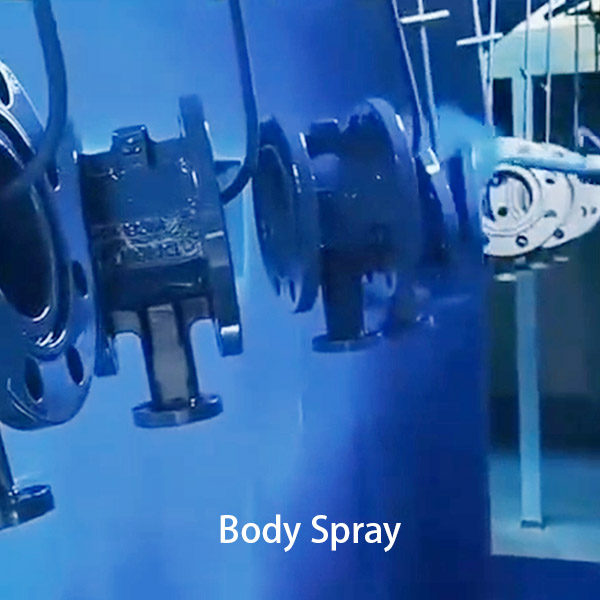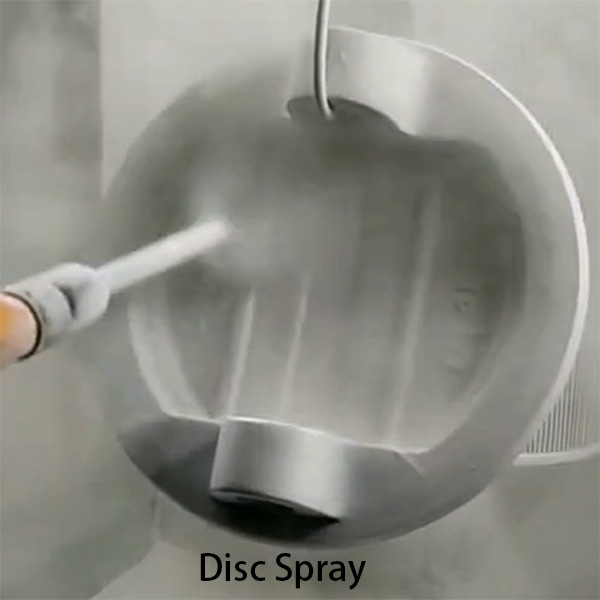According to investigation and analysis, corrosion is one of the important factors causing damage to butterfly valves. Because the inner cavity is in contact with the medium, it is extremely corroded. After corrosion, the valve diameter becomes smaller and the flow resistance increases, which affects the transmission of the medium. The surface of the valve body is mostly installed on the ground or underground. The surface is in contact with the air and the air is moist, so it is prone to rust. The valve seat is completely covered where the inner cavity is in contact with the medium. Therefore, the surface coating treatment of the valve body and valve plate is the most cost-effective protection method against corrosion in the external environment.
1. The role of butterfly valve surface coating
01. Valve body material identification
The surface layer color is applied to the unmachined surfaces of the valve body and bonnet. Through this color marking, we can quickly determine the material of the valve body and better understand its characteristics.
| Valve Body Material | Paint Color | Valve Body Material | Paint Color |
| Cast Iron | Black | Ductile Iron | Blue |
| Forged Steel | Black | WCB | Grey |
02. Shielding effect
After the valve body surface is coated with paint, the valve body surface is relatively isolated from the environment. This protective effect can be called a shielding effect. However, it must be pointed out that a thin layer of paint cannot provide an absolute shielding effect. Because polymers have a certain degree of breathability, when the coating is very thin, the structural pores allow water and oxygen molecules to pass freely. Soft-sealing valves have strict requirements on the thickness of the epoxy resin coating on the surface. In order to improve the impermeability of the coating, anti-corrosion coatings should use film-forming substances with low air permeability and solid fillers with high shielding properties. At the same time, the number of coating layers should be increased so that the coating reaches a certain thickness and is dense and non-porous.
03.Corrosion inhibition
The internal components of the paint react with the metal to passivate the metal surface or generate protective substances to improve the protective effect of the coating. For valves with special requirements, you must pay attention to the paint composition to avoid serious adverse effects. In addition, cast steel valves used in oil pipelines can also act as organic corrosion inhibitors due to the degradation products generated under the action of some oils and the drying action of metal soaps.
04. Electrochemical protection
When the dielectric penetrating coating comes into contact with the metal surface, electrochemical corrosion under the film will form. Metals with higher activity than iron are used as fillers in coatings, such as zinc. It will play a protective role as a sacrificial anode, and the corrosion products of zinc are salt-based zinc chloride and zinc carbonate, which will fill the gaps in the film and make the film tight, greatly reducing corrosion and extending the service life of the valve.
2. Coatings commonly used on metal valves
The surface treatment methods of valves mainly include paint coating, galvanizing and powder coating. The protective period of paint is short and cannot be used under working conditions for a long time. The galvanizing process is mainly used in pipelines. Both hot-dip galvanizing and electro-galvanizing are used. The process is complex. The pretreatment uses pickling and phosphating processes. There will be acid and alkali residues on the surface of the workpiece, leaving corrosion Hidden danger makes the galvanized layer easy to fall off. The corrosion resistance of galvanized steel is 3 to 5 years. The powder coating used in our Zhongfa valves has the characteristics of thick coating, corrosion resistance, erosion resistance, etc., which can meet the requirements of the valves under the use conditions of the water system.
01. Valve body epoxy resin coating
Has the following characteristics:
·Corrosion resistance: Epoxy resin-coated steel bars have good corrosion resistance, and the bonding strength with concrete is significantly reduced. They are suitable for industrial conditions in humid environments or corrosive media.
·Strong adhesion: The existence of polar hydroxyl groups and ether bonds inherent in the epoxy resin molecular chain makes it highly adhesion to various substances. The shrinkage of epoxy resin when cured is low, the internal stress generated is small, and the protective surface coating is not easy to fall off and fail.
·Electrical properties: The cured epoxy resin system is an excellent insulating material with high dielectric properties, surface leakage resistance, and arc resistance.
·Mold Resistant: The cured epoxy resin system is resistant to most molds and can be used in harsh tropical conditions.
02. Valve plate nylon plate material
Nylon sheets are extremely corrosion-resistant and have been successfully used in many applications such as water, mud, food and seawater desalination.
·Outdoor performance: The nylon plate coating can pass the salt spray test. It has not peeled off after being immersed in sea water for more than 25 years, so there is no corrosion to metal parts.
·Wear resistance: Very good wear resistance.
·Impact resistance: No signs of peeling off under strong impact.
3. Spraying process
The spraying process is workpiece pretreatment → dust removal → preheating → spraying (primer - trimming - topcoat) → solidification → cooling.
Spraying Spraying mainly uses electrostatic spraying. According to the size of the workpiece, electrostatic spraying can be divided into powder electrostatic spraying production line and powder electrostatic spraying unit. The two processes are the same, and the main difference is the turnover method of the workpiece. The spray production line uses a transmission chain for automatic transmission, while the spray unit is manually hoisted. The thickness of the coating is controlled at 250-300. If the thickness is less than 150 μm, the protective performance will be reduced. If the thickness is greater than 500 μm, the coating adhesion will decrease, the impact resistance will decrease, and the powder consumption will increase.





